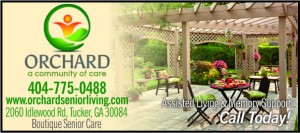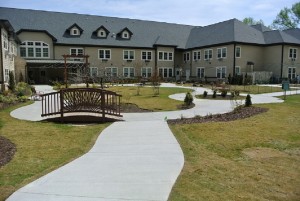Can You Design a One Stop Shop Assisted Living Building?
Is it Possible to Design an Assisted Living Building to be a One Stop Shop?
The answer is yes, it is possible in theory, however the better question is, can a one stop shop design offer the best quality of life to most of the residents? I would venture to say no, because to design a community to fit your resident’s needs, you have a clear picture of who your resident will be, and design for their needs and preferences.
Who Lives in a One Stop Shop Design Building?
Many Assisted Living Communities attempt to be home, for a wide range of seniors, with a wide range of needs. This spectrum includes seniors with no to early mild dementia and no care needs, seniors that require ADL assistance ranging from standby to full assistance, as well as seniors in the late mild to late moderate dementia. Although these communities can market to a broader senior population, are all their residents getting the most of their community? Let’s break the spectrum into 4 groups of seniors and explore this further.
The Design Element of a One Stop Shop. Let’s Break It Down.
I am listing just a few of the preferences as well as needs, for each of the four groups, that a one stop shop building will need to accommodate.
Group 1 (independent senior that still drives some)
- Large floor plans, full kitchens (this group has no care costs to incur now)
- Multiple Dining Venues such as a bistro where you can get a sandwich (so they can come and go without missing a meal)
- Flexible Dining Times
- A Bar for Happy Hour
- Computer Classes
- Lots of Exercise Classes such as dancing and yoga, an Exercise Facility with exercise bikes
- Lots of different community amenities throughout- completely fine with a multi-story building, if it means more amenities
Group 2 (needs stand by ADL assistance)
- Less expensive smaller floor plans options (this group is incurring some care costs)
- Transportation offered by the community
- Exercise Classes such as chair exercises
- Multiple Dining Venues
- Amenities and Activities near their own living quarters
Group 3 (Seniors who need hands on ADL assistance)
- Less expensive smaller floor plans options (this group incurring the most care costs)
- Visiting medical professionals (limited mobility makes traveling difficult)
- Amenities very near to living quarters, as well as mobile amenities that can come to them
- Amenity areas they can use- this group can no longer enjoy an exercise bike, or a pool
Group 4 (Senior with late Mild-Moderate Dementia)
- Smaller floor plans to minimize confusion. Also incurring care costs at this level
- Set meal times in one place (we know structure is key to those with dementia)
- This one dining area should be fairly close to living quarters to minimize confusion
- Dementia friendly amenity areas such as a multi-purpose activity room (computer lab or a library are no longer an important amenity for many of these residents. Many of these residents are no longer able to drink so a bar is not important)
- Visiting medical professionals
- Smaller building design to lessen the confusion. (this group can no longer safely navigate a large building and find spread out amenity areas)
Is There Some Overlap with Needs and Preferences between Some of the Groups?
Although some of the needs and preference to overlap, there becomes a point that the preference of one group of seniors are the opposite of the preferences/needs of another group of seniors. Group 1 wants active, spread out amenities, in and outside the community. They want to do these activities in amenity areas through out the building. Group 2’s preferences do somewhat overlap with group 1. However, when you get to group 3 and 4, you notice no overlapping, but on the contrary conflicting needs and preferences. Another area where needs and preferences come to a head for the 4 groups is dining. Group 1 wants flexible dining times and multiple venues. Group 2 may also use these, but when you get to group 3, who is not able to get to these venues without assistance that preference diminishes. In many cases group 3 needs assistance with dining, such as making sure their foods are cut up, salad dressing is open, so a grab and go bistro is no longer a needed amenity. When you get to group 4, you notice a conflicting need with groups 1 and 2. Group 4 likes to eat at the same time, in the same place, with the same people for the most part. Also notice that the amenity preferences decrease as the care needs increase. Group 1 are the most active seniors, who also have the most amenity preferences.
The Take Away..
There are many areas where design needs and preferences overlap for some groups. They overlap for groups with similar physical and cognitive deficits. Group 1 had some similar preferences as group 2, but very few if any of the same preferences of group 3 and 4. Also once you got to Group 3 and 4, some of the preferences turn into needs due to physical and cognitive deficits.
One building can be designed for a spectrum of needs, but when that spectrum gets too large, some group will be left out from enjoying the entire community. Although it is easier to lease up a building with a larger pool of prospects, it is very difficult to cost effectively design a space that meets such a large spectrum of needs. The design element of a one stop shop is difficult to manage, although this element is a piece of cake compared to the care and engagement piece. It is almost impossible to provide care and engagement in a one stop shop community, and to do it well for everyone.
Visit http://stage-osl.daveminotti.com/category/blog/ to view future posts about providing care and engage ment in a one stop shop building.
ment in a one stop shop building.



 Hot weather can be dangerous here in Georgia, and seniors are more inclined to its threat. Elderly heat stroke and heat exhaustion are real problems. There are several reasons for elderly heat vulnerability. A person’s ability to notice fluctuations in their body temperature decreases with age. Many seniors also have underlying health conditions that make them less able to adjust to heat or medication that can cause dehydration. Fortunately, only a few simple precautions are all that’s needed to keep safe.
Hot weather can be dangerous here in Georgia, and seniors are more inclined to its threat. Elderly heat stroke and heat exhaustion are real problems. There are several reasons for elderly heat vulnerability. A person’s ability to notice fluctuations in their body temperature decreases with age. Many seniors also have underlying health conditions that make them less able to adjust to heat or medication that can cause dehydration. Fortunately, only a few simple precautions are all that’s needed to keep safe.